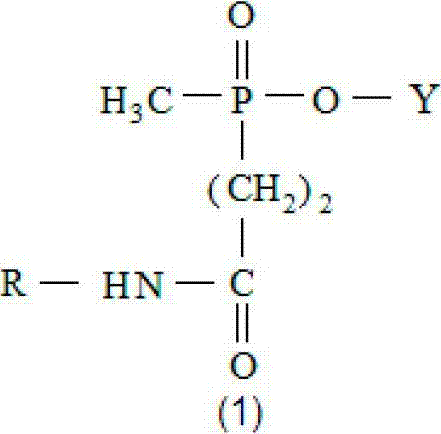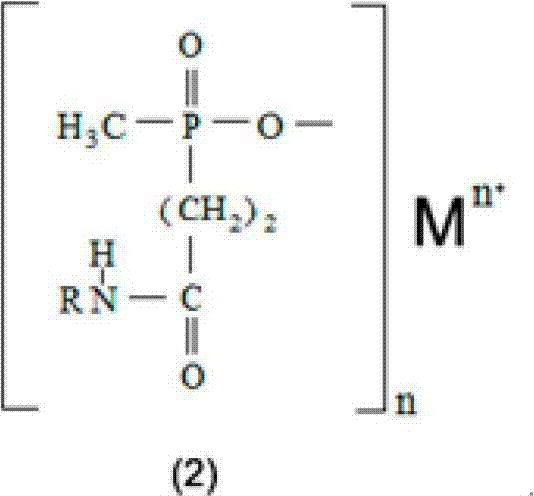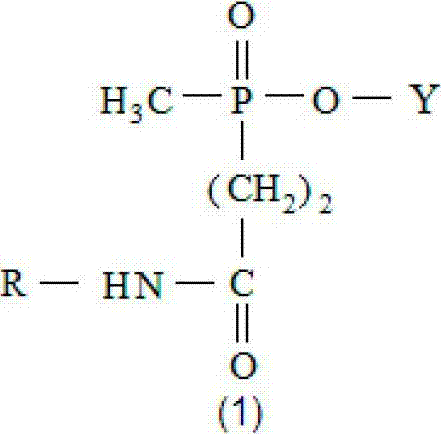Flame retardant composite of epoxy resin and preparation method thereof
A technology of flame retardant composition and epoxy resin, which is applied in the field of flame retardants, can solve the problems of poor compatibility between flame retardants and resins in the mechanical properties of flame retardant compositions, and achieve improved mechanical properties, simple steps, and increased compatibility sexual effect
- Summary
- Abstract
- Description
- Claims
- Application Information
AI Technical Summary
Problems solved by technology
Method used
Image
Examples
Embodiment 1
[0035] Methyl (N-phenyl-3-propionyl) phosphinic acid is ground to 5-10 μm with a high-speed ball mill, and bisphenol A epoxy resin (trade name CYD-127, epoxy equivalent g / eq180-190) 100.0 g. Add 15.0g of methyl (1-propionanilide) phosphinic acid into 100g of CYD-127, completely melt the flame retardant at the melting point of 145°C and stir evenly. Then, 26g of 4,4-diaminodiphenylsulfone was also mixed into the epoxy resin, stirred at high speed for 3 minutes, and the preparation of composition 1 was completed.
[0036] The composition 1 was poured into a mold and shaped at 160°C / 3 hours to obtain a flame-retardant composite material. The composite material has good transparency, a glass transition temperature of 143°C, an oxygen index of 29.1, and a vertical combustion rating of UL94V-0.
Embodiment 2
[0038] Grind methyl (N-phenyl-3-propionyl)phosphinate to 5-10 μm with a high-speed ball mill, and bisphenol A epoxy resin (trade name CYD-128, epoxy equivalent g / eq184- 194) Take 100.0g. Add 20.0g of methyl (N-phenyl-3-propionyl)phosphinate into 100g of CYD-128, completely melt the flame retardant at the melting point of 145°C and stir evenly. Then cool to 80° C., 23.4 g of 4,4-diaminodiphenylmethane as a curing agent was added to the epoxy resin system, stirred at high speed for 3 minutes, and the preparation of composition 2 was completed.
[0039] The composition 2 was poured into a mold and shaped at 150°C / 3 hours to obtain a flame-retardant composite material. The composite material has good transparency, a glass transition temperature of 146°C, an oxygen index of 28.4, and a vertical combustion rating of UL94V-0.
Embodiment 3
[0041] Grind methyl (N-phenyl-3-propionyl) aluminum phosphinate to 5-10 μm with a high-speed ball mill, and bisphenol A epoxy resin (trade name CYD-128, epoxy equivalent g / eq184-194 ) take 100.0g. Add 15.0g of aluminum methyl (N-phenyl-3-propionyl)phosphinate to 100g of CYD-128, completely melt the flame retardant at the melting point of 145°C and stir evenly. Then, 10 g of dicyandiamide was selected as the curing agent, and 1.2 g of 2-methylimidazole was selected as the curing accelerator. After melting the curing agent and 2-methylimidazole, they were also added to the epoxy resin system and stirred at high speed for 3 minutes. Composition 3 Preparation is complete.
[0042] The composition 3 was poured into a mold and formed by a process of 140°C / 3 hours to obtain a flame-retardant composite material. The composite material has good transparency, the oxygen index reaches 30.4, the glass transition temperature is 178°C, and the vertical combustion rating reaches UL94V-0. ...
PUM
| Property | Measurement | Unit |
|---|---|---|
| Glass transition temperature | aaaaa | aaaaa |
| Glass transition temperature | aaaaa | aaaaa |
| Glass transition temperature | aaaaa | aaaaa |
Abstract
Description
Claims
Application Information
 Login to View More
Login to View More - R&D
- Intellectual Property
- Life Sciences
- Materials
- Tech Scout
- Unparalleled Data Quality
- Higher Quality Content
- 60% Fewer Hallucinations
Browse by: Latest US Patents, China's latest patents, Technical Efficacy Thesaurus, Application Domain, Technology Topic, Popular Technical Reports.
© 2025 PatSnap. All rights reserved.Legal|Privacy policy|Modern Slavery Act Transparency Statement|Sitemap|About US| Contact US: help@patsnap.com



